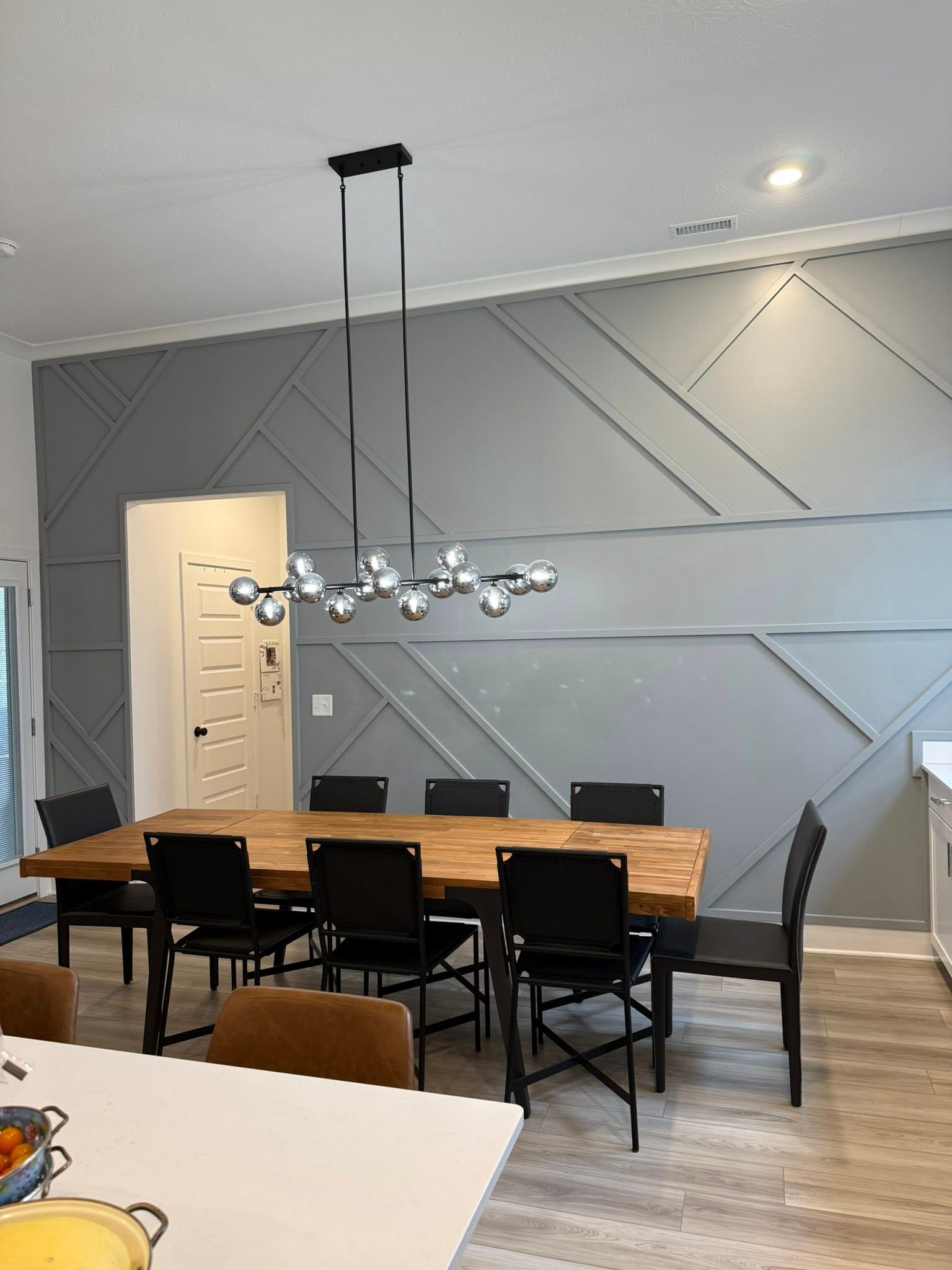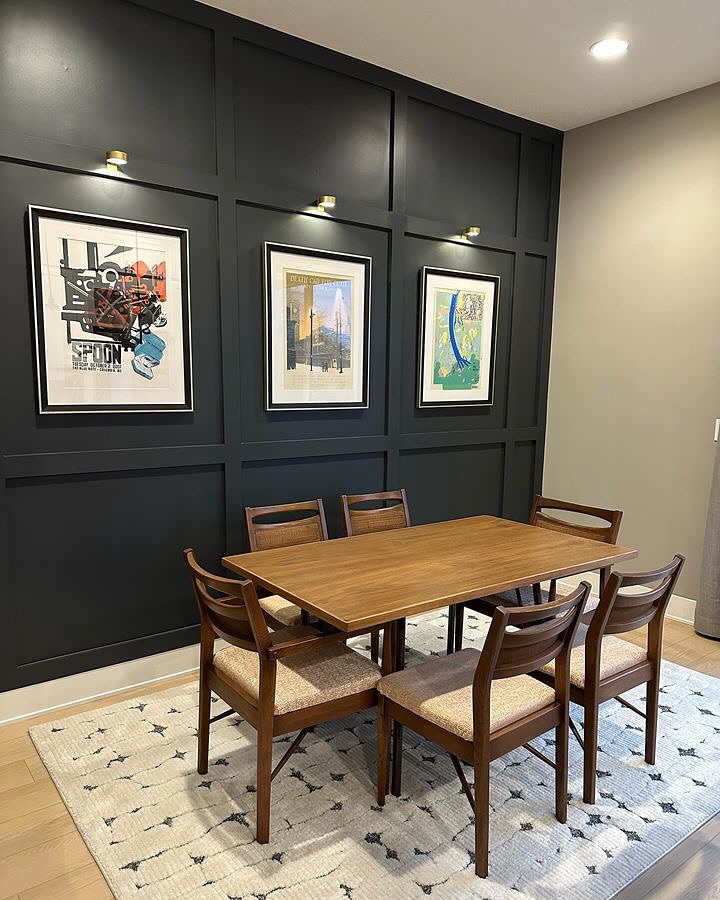Those Carmel dining rooms turn heads from the curb, but do they deliver the same impact when guests arrive for their first holiday meal? Walk through any Pulte community in Meadowstone, tour Shoopman’s luxury builds in Waterfront of West Clay, or visit Old Town Design Group’s custom homes throughout Carmel’s 223 subdivisions, and you’ll find generous dining spaces with great natural light and open flow. But builders deliver these rooms with minimal architectural detail, leaving walls bare and ceilings flat when holiday hosting demands more.
Thanksgiving and holiday gatherings expose these limitations quickly. That empty wall behind the buffet table needs substance. The plain ceiling above your carefully set table lacks the polish your meal deserves. The absence of built-in serving infrastructure means juggling platters between kitchen and table all evening. Smart families address these issues before the holidays arrive, adding trim upgrades that transform builder-grade dining spaces into rooms worthy of memorable celebrations.
These six trim and millwork upgrades work specifically with Carmel floor plans, complementing the architecture Pulte, Shoopman, and Old Town Design Group establish while adding the custom details that make hosting feel effortless rather than stressful. From chair rail wainscoting that anchors furniture arrangements to chandelier box-outs that center lighting perfectly over your table, these improvements create dining rooms that function as beautifully as they look.
Upgrade 1: Chair Rail Wainscoting That Works With Standard Carmel Ceiling Proportions
Chair rail wainscoting adds architectural substance to blank dining room walls while creating practical protection in high-traffic spaces. The key lies in proper height proportions that work with Carmel’s typical 9-10 foot ceilings rather than fighting them.
The traditional chair rail height of 36 inches works beautifully in rooms with 9-foot ceilings, creating balanced proportions that divide walls into pleasing thirds when paired with crown molding. Pulte dining rooms in Meadowstone benefit from this classic approach, where the lower third features beadboard or raised panel wainscoting below the rail, middle section carries paint or wallpaper, and upper section transitions to crown molding and ceiling.
For Carmel homes with 10-foot ceilings—common in Shoopman and Old Town Design Group custom builds—raising the chair rail to 42 inches maintains proper proportional relationships. This higher placement works especially well when paired with taller baseboards (6-8 inches) that create vertical rhythm through the entire wall treatment. The rail itself should be substantial enough to read as intentional detail rather than thin trim that disappears visually.
Material selection affects both appearance and durability. MDF provides smooth surfaces perfect for painted finishes and costs less than solid wood, while poplar or maple offers superior durability in active dining spaces where chairs contact walls regularly. The wainscoting below the rail can feature simple beadboard for cottage charm, raised panels for traditional formality, or board-and-batten for transitional style that bridges classic and contemporary design.
Upgrade 2: Picture Rail Systems For Rotating Seasonal Art and Décor
Picture rail molding installed 12-18 inches below the ceiling creates flexible display systems perfect for families who rotate holiday decorations and seasonal art. This upgrade addresses a common Carmel dining room challenge—how to personalize spaces without permanent wall damage that might void builder warranties or create patching hassles.
The rail itself runs continuously around the dining room perimeter at consistent height, typically 10-12 inches below crown molding or ceiling. Specialized hooks drop from the rail on thin cables, supporting framed art, mirrors, or seasonal wreaths without requiring wall anchors. This system particularly benefits Pulte homeowners who want flexibility as tastes change or children contribute artwork that deserves display during family gatherings.
Installation requires precision to ensure the rail runs perfectly level despite typical ceiling irregularities. Professional installation guarantees the rail can support substantial weight—important when displaying large mirrors or framed family photographs that anchor holiday tablescapes. The rail profile should coordinate with existing trim language established in adjacent living spaces, creating visual flow rather than isolated detail that feels added later.
The flexibility of picture rail systems shines during holiday seasons. Thanksgiving wreaths and autumn arrangements give way to winter greenery and holiday cards, then spring botanicals and summer landscapes—all without touching existing wall surfaces. For families hosting extended relatives or multi-generational gatherings, the ability to showcase family history through rotated photographs adds meaningful personalization to holiday meals.
Upgrade 3: Coffered Ceiling Retrofits Without Full Renovation
Coffered ceilings traditionally require extensive construction, but modern retrofit techniques bring this luxury detail to existing Carmel dining rooms without full renovation. This upgrade transforms plain drywall ceilings into architectural statements that frame chandeliers while adding perceived height and sophistication.
The simplest coffered ceiling approach uses applied trim creating grid patterns directly on existing drywall. Professional carpenters frame rectangular or square coffers sized proportionally to room dimensions—typically 24-36 inch coffers in standard Carmel dining rooms measuring 12×14 to 14×16 feet. Shoopman homes with their generous dining proportions can accommodate larger coffer sizes that create dramatic impact without overwhelming the space.
Material selection balances weight and appearance. Lightweight polyurethane beams replicate traditional wood appearance while mounting directly to ceilings without structural reinforcement. These beams come pre-primed and ready for paint, allowing perfect color matching to existing trim. For families seeking authentic wood character, pine or poplar beams offer traditional appeal with modest weight that existing ceiling framing can support.
Color treatment dramatically affects how coffered ceilings read in the space. Painting coffer interiors slightly darker than surrounding ceiling creates depth without heaviness—imagine soft gray coffers against white ceiling fields. Alternatively, painting the entire ceiling including coffers in one color maintains clean contemporary feel while adding architectural texture through shadow lines alone. Old Town Design Group dining rooms often feature these subtle approaches that add sophistication without period-specific styling.
Upgrade 4: Built-In Buffet Cabinetry Plus Wine Storage
Built-in buffets solve Carmel’s most common dining room hosting challenge—where to stage food, store serving pieces, and display wine when entertaining. These installations transform empty walls into functional serving stations that look like original architecture rather than furniture additions.
Sizing buffet built-ins requires careful planning around room proportions and traffic patterns. A typical installation spans 6-8 feet of wall length and projects 18-24 inches into the room—enough depth for serving platters and wine storage without blocking circulation around the table. Pulte dining rooms in communities like Meadowstone benefit from built-ins positioned on walls opposite entryways, creating natural serving flow without interfering with guest movement.
Upper cabinets with glass-front doors display china and glassware while protecting them from dust between uses. Lower cabinets feature deep drawers for table linens, pull-out shelves for small appliances, and specialized storage for wine bottles. The center section often includes granite or quartz counter surface perfect for setting out appetizers, carving roasts, or staging desserts during multi-course meals. This counter typically sits 36 inches high—standard buffet height that works comfortably for both setting down and picking up serving pieces.
Wine storage integration separates amateur installations from professional work. Built-in wine racks sized for standard 750ml bottles can hold 12-24 bottles within base cabinetry, while wine refrigeration units fit seamlessly into lower cabinet sections. Families serious about wine collections might include temperature-controlled storage with glass doors that showcase bottles while protecting them from light and temperature fluctuations.
Upgrade 5: Chandelier Box-Outs That Center Perfectly Over Tables
Few dining room details frustrate Carmel homeowners more than off-center lighting. Builders install electrical boxes based on room dimensions rather than furniture placement, resulting in chandeliers hanging awkwardly between table edges rather than perfectly centered above. Chandelier box-outs solve this problem while adding architectural detail to plain ceilings.
The box-out itself consists of recessed ceiling detail measuring 3-6 feet square or circular, depending on room shape and chandelier style. Professional installation involves relocating the electrical junction box to the true center of your dining table’s placement, then building the recessed box around that new location. The depth of recess typically measures 6-12 inches, creating shadow detail that frames the chandelier while adding visual interest to otherwise flat ceilings.
Paint treatment within box-outs creates subtle sophistication appropriate for Carmel’s design aesthetic. Painting the recessed area slightly darker than the surrounding ceiling adds depth without heaviness—soft gray or warm beige work beautifully in most Carmel homes. Alternatively, continuing the wall color up into the box-out creates dramatic effect, especially when walls feature rich tones popular in 2025 dining trends.
LED tape lighting installed around box-out perimeters adds layers of illumination beyond the chandelier alone. This accent lighting can be dimmed independently, creating ambient glow during intimate dinners while the chandelier handles task lighting during food service. Smart controls allow preset scenes—bright for holiday meal preparation, moderate for dinner service, dim for dessert and conversation—all adjustable from phones or voice commands.
Upgrade 6: Crown Molding That Coordinates With Adjacent Living Spaces
Crown molding provides the finishing touch that ties dining room upgrades together while creating visual flow into adjacent living areas. The key lies in selecting profiles and installation heights that coordinate with existing trim throughout your Carmel home.
Profile selection should match or complement crown already installed in connected spaces. If your Pulte great room features 4-inch crown molding, the dining room should use the same profile or a coordinated design within the same style family. This consistency creates architectural cohesion that suggests comprehensive planning rather than piecemeal upgrades completed over time.
Installation height matters tremendously in rooms with varying ceiling treatments. In dining rooms with coffered ceilings, crown typically installs at the perimeter where walls meet ceiling, with coffered beam details occurring lower. In rooms with picture rail systems, crown sits above the rail, creating layered detail that adds architectural richness without visual confusion. The spacing between different horizontal elements—baseboards, chair rails, picture rails, crown—should follow consistent proportional relationships throughout.
Paint treatment affects how crown molding reads in the space. Traditional approaches paint crown the same color as ceilings, creating the illusion of taller walls by continuing the ceiling plane downward. Contemporary treatments paint crown to match wall color or use accent colors that bridge wall and ceiling tones. For Carmel homes featuring the rich dining room colors trending in 2025—deep greens, warm chocolates, elegant burgundies—crown molding painted in lighter versions of wall colors creates sophisticated transitions.
How These Upgrades Work Together In Carmel Dining Rooms
The six upgrades outlined here function best when coordinated as a complete system rather than installed individually. Chair rail wainscoting establishes base proportions that picture rail systems complement higher on walls. Coffered ceilings frame chandelier box-outs while crown molding ties everything together. Built-in buffets add functional infrastructure that makes hosting actually work.
Together, these elements transform builder-grade dining spaces into custom rooms worthy of Carmel’s established neighborhoods and entertaining traditions. The investment ranges from moderate (crown molding and chair rail) to substantial (coffered ceilings and built-in buffets), but all contribute directly to both daily enjoyment and eventual resale value.
Most importantly, these upgrades solve real hosting challenges Carmel families face. Storage for serving pieces and wine bottles eliminates kitchen-to-dining-room traffic jams. Proper lighting centered over tables creates ambiance without awkward shadows. Picture rail systems allow seasonal personalization without wall damage. The result is dining rooms that handle Thanksgiving gatherings, holiday parties, and Sunday family dinners with equal grace.
Ready to Transform Your Carmel Dining Room Before the Holidays?
At Radford Woodworks, we specialize in dining room millwork that complements Carmel’s most popular floor plans from Pulte, Shoopman, and Old Town Design Group. Our experience with local architectural styles ensures upgrades integrate seamlessly with your home’s existing design language while adding the custom details that make hosting effortless.
Ready to create a dining room worthy of your holiday table? Get your personalized quote by filling out our form at radfordwoodworks.com/contact or calling (317) 739-8555.
Your Carmel home deserves dining spaces that match the quality of meals you serve. Let’s create them together.






